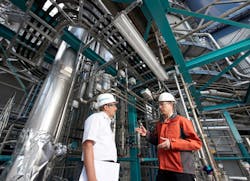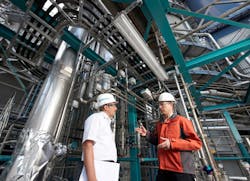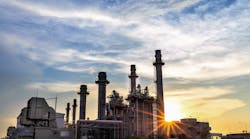View inside the pilot CO2 capture plant at Staudinger Power Station in Grosskrotzenburg near Hanau, Germany.
Siemens Energy completed the first test phase of its carbon dioxide capture process in a pilot facility at the Staudinger power plant, owned and operated by E.ON. In the first test phase, process efficiency, long-term chemical stability of the scrubbing agent, and emissions were investigated in the pilot facility under real power plant conditions.
After more than 3000 operating hours since the facility was commissioned in September 2009, Siemens demonstrated that the post-combustion capture process achieves a carbon dioxide capture efficiency of over 90 percent with practically zero solvent emissions.
According to the company, the high level of stability of the solvent and the low losses will have a positive impact on the operating costs of carbon capture facilities. Since the scrubbing agent, an aqueous amino acid salt solution, is non-volatile, there are practically no solvent emissions at the outlet of the capture facility.
In contrast to conventional carbon capture processes, such as those using amines, the Siemens PostCap process does not require any complex downstream scrubbing of the flue gas after the capture of the carbon dioxide.
The pilot project at Staudinger power plant is sponsored by E.ON and the German Federal Ministry of Economics and Technology within the framework of the COORETEC Initiative. This initiative is part of Germany”s 5th Energy Research Program, titled “Innovation and New Energy Technologies,” which promotes research into and the development of low-carbon power plant technologies.



